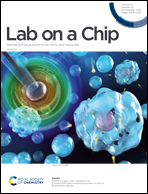Microfluidic outer blood–retinal barrier model for inducing wet age-related macular degeneration by hypoxic stress†
Abstract
Wet age-related macular degeneration (AMD) is a severe ophthalmic disease that develops in the outer blood–retinal barrier (oBRB), involving two types of cells, the retinal pigment epithelium (RPE) and the choriocapillaris endothelium (CCE). Unfortunately, the pathogenesis of AMD is unclear, and the risk of the only effective therapy (Anti-VEGF injection) has been consistently argued. Also, since oBRB is hard to observe in vivo, an in vitro model for the pathological study is necessary. Here, we propose an advanced oBRB model, enhanced in two major ways: fully vascularized CCE and the in vivo analogous distance between RPE and CCE. Our model consists of an RPE (ARPE-19) monolayer with adjacent CCE (HUVEC) embedded fibrin gel in the microfluidic chip and required four days to construct an oBRB. Notably, the intercellular distance was tuned to the in vivo scale (<100 μm) without any extraneous scaffold in between. Thus, the two cell layers can interact freely through the extracellular matrix (ECM) in vivo. This is significant as wet AMD is mainly developed through broken intercellular interaction. Thanks to this in vivo similarity, the model incubated under hypoxic conditions, similar to an oxygen-induced retinopathy animal model, showed upregulated vascularization comparable to the AMD condition. We envisage that our model can be used to assist the investigation of AMD.



 Please wait while we load your content...
Please wait while we load your content...